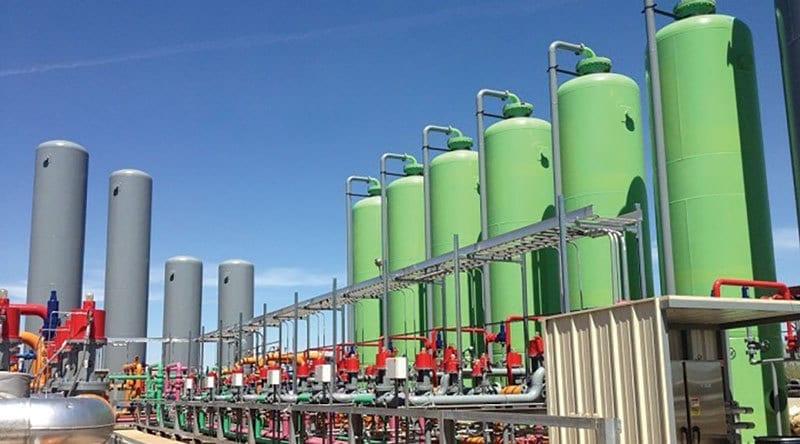In 2018, renewable natural gas (RNG) on-road fuel use reached an historic high. Of the 645 million gasoline gallon equivalent of natural gas used as a motor fuel last year, more than 204 million gasoline gallon equivalent was renewable—equating to 32%. [1]
In states with a Low Carbon Fuel Standard program in place, like California, that figure is well over 90%. And an increasing number of natural gas fuelers are pledging to dispense 100% RNG at their stations within the next decade as more and more biomethane becomes available and new production facilities come on line.
Over the last five years, RNG use as a transportation fuel has increased 577%, displacing over seven million tons of carbon dioxide equivalent (CO2e).
Over the last five years, RNG use as a transportation fuel has increased 577%, displacing over seven million tons of carbon dioxide equivalent (CO2e). Put into perspective, RNG motor fuel is:
- Lowering greenhouse gas emissions equivalent to removing over 5 million gasoline passenger cars from our roads for one year;
- Reducing CO2 emissions equivalent to almost 816 million gallons of gasoline or 713 million gallons of diesel consumed. That’s equal to the total energy used by 868,321 US homes for one year;
- Avoiding greenhouse gas emissions equivalent to running 1,537 wind turbines for one year or replacing more than 275 million traditional lightbulbs with LEDs; and
- Sequestering carbon equal to growing 120 million tree seedlings for ten years or 5 million acres of US forests for one year.[2]
Captured above ground from organic material in agricultural, wastewater, landfill or food waste, RNG produces net carbon-neutral and even net carbon-negative results when fueling on-road vehicles like short- and long-haul trucks, transit buses, and refuse and recycling collection vehicles. RNG fuel in 2018 had an EER-adjusted carbon intensity as low as -303.30 according to the California Air Resources Board. By comparison, California’s electricity grid rated between 25.0 and 38.95.[3]
Proven and affordable natural gas vehicle technology is over 90% cleaner than federal EPA nitrogen oxide (NOx) emission standards. And when those American-made heavy-duty trucks and buses are fueled with renewable natural gas, they are up to 125% cleaner than the cleanest diesel technology in terms of carbon emissions. RNG-fueled vehicles are the most immediate and cost-effective heavy-duty option when seeking to reduce emissions and combat climate change.
Unlike other biofuels, the production of renewable natural gas doesn’t require large amounts of land to be clear cut and dedicated to, for instance, soybean production. It doesn’t displace food production or require significant volumes of water or nitrogen-based fertilizer to be used in its creation.
The total number of North American biomethane production facilities has increased more than two-and-a-half times in the past five years.
The total number of North American biomethane production facilities has increased more than two-and-a-half times in the past five years; there are almost 100 domestic biomethane production facilities in use today. While 34 US states produce geologic natural gas, the potential to produce renewable natural gas exists in every US state and the District of Columbia by taking the problem of fugitive methane gas created from organic waste, capturing it, then using it to fuel traditionally heavy-carbon freight and transit transportation applications.
In addition to its clean air and climate benefits, the development of RNG facilities also supports the agriculture industry by providing producers with new revenue streams while addressing the growing solid waste disposal issue, supporting regional watershed management efforts, and mitigating nitrogen runoff concerns.
RNG facilities also support the agriculture industry by providing producers with new revenue streams while addressing the growing solid waste disposal issue, supporting regional watershed management efforts, and mitigating nitrogen runoff concerns.
Medium- and heavy-duty natural gas vehicles are proven, scalable, and affordable. NGVs fueled with biomethane are the most impactful commercially-available alternative fueled vehicles today, eliminating virtually all pollutant and toxic emissions and creating a clean climate product with no carbon footprint.
Find out more about RNG’s transportation impact and NGVAmerica’s efforts to develop a growing, profitable, and sustainable market for vehicles powered by natural gas or biomethane.
[1] Total Natural Gas in Transportation Figure derived from U.S. EIA’s Annual Energy Outlook (2019). RNG numbers derived from U.S. EPA Renewable Fuel Standard Program reporting.
[2] 7,251,351 metric tons of CO2e figure calculated using CARB’s LCFS carbon intensity numbers and the U.S. DOE’s Argonne National Laboratory Heavy-Duty Vehicle Emission Calculator. GHG equivalency results calculated using the U.S. EPA’s calculator at: https://www.epa.gov/energy/greenhouse-gas-equivalencies-calculator.
[3] California Air Resources Board, Low Carbon Fuel Standard Program, Certified Fuel Pathways, 2017. Note: Carbon intensities noted are from California Air Resources Board fuel pathways through 2018.


